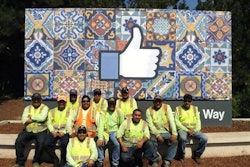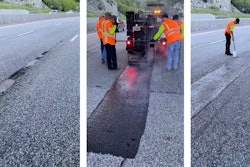
In today’s day and age with the internet, practically everyone could legitimately be your customer. Perhaps you’ve heard of Google? One simple search can put customers across the country in touch with your business. Still many pavement maintenance contractors haven't invested the time or resources into building a successful website.
But why not? Reports show that over 81% of consumers conduct online research before making any kind of buying decision and if your company isn't listed, how can they know you even have a service to offer them?
This is why Zach Lear, owner of California Striping & Sealcoating, made creating a website his top priority when he started his business in 2010. Even if he had no idea where to start.
"I really had no clue what I was doing," Lear says. "I knew it was critical for me to get my website at the top of search rankings to generate business, but I had no idea how."
Getting to Know Google
Lear spent the better part of two full weeks making phone calls to GoDaddy (a website domain service) and Wix (a website hosting service) to get his website up and running. After investing the time in getting his website up, Lear knew he had to get customers to visit the site, but how?
When it comes to search engine rankings, there are two sides to the story. There are organic search rankings and those search rankings that are paid for. Unless your website has zero competition or you have ample amounts of time on your hands, it's a good idea to start driving traffic to your site with paid ads. Luckily, Google can be very helpful in creating ad campaigns to help.
"I spent hours on the phone with Google," Lear says. "They suggested cost per click (CPC) advertising through Google AdWords."
Google AdWords is the single most popular CPC advertising system in the world. The AdWords platform enables businesses to create ads that appear on Google’s search engine and other Google properties.
AdWords operates on a pay-per-click model, in which users bid on keywords and pay for each click on their advertisements. Every time a search is initiated, Google digs into the pool of AdWords advertisers and chooses a set of winners to appear in the valuable ad space on its search results page. The “winners” are chosen based on a combination of factors, including the quality and relevance of their keywords and ad campaigns, as well as the size of their keyword bids.
"AdWords is a good place for companies to start with search engine optimization (SEO) because your company will show up on top of the Google results,” Lear says. “Even if your website is not what they are looking for, it's still driving a lot of traffic to your website, which increases your organic ranking.”
Lear says he started his AdWords campaign very broad, trying to get as many customers as possible to his site. “Basically if a customer typed in anything relevant to parking lot striping, sealcoating, signage, etc, I made sure I was going to show up," Lear says.
However, he wasn’t seeing the return on his investment that he expected going this route.
Growing “Organically”
Although Lear began seeing clicks to his website, he received few phone calls for business (see sidebar). After receiving a $1,500 bill from Google that first month, Lear decided to try SEO on his own to grow his website organically, or in other words, the hard way.
Organic SEO is the other side of the search ranking coin and is a phrase used to describe processes to obtain a natural placement on organic search engine results pages (SERPs). Some examples of techniques used for organic SEO include using keywords and keyword analysis, backlinking, link building to improve link popularity, and writing content relevant for website visitors.
Lear used his knowledge of SEO to help expand the reach of his company through keywords he embedded on his own website platform instead of paying Google to do it for him through AdWords.
“Using my website and the website hosting page, I embedded keywords myself for SEO searches,” Lear says. “I typed in any keywords relevant to parking lot striping, anything needing ADA compliance. I probably have about 70 keywords on there. I spent time tweaking, going in to different screens, adding keywords on pictures. I did everything I could to improve our organic rankings. How successful it is really depends on how long you want to spend on it.”
This is hard work and it’s paid off when a company based out of North Carolina found his California-based business through a Google search.
“We signed a deal with Alutiiq who is based out of North Carolina,” Lear says. “Their business provides services to the federal government and they have the contracts for all the Navy bases in San Diego and the surrounding state (around 40).
“They contacted me through a Google search. We went out, did one job for them and secured their business. Since that job we’ve done all the Navy bases in San Diego, sealed the Navy Seal base on Coronado Island and are gaining business across the country from them.
“It’s crazy how important my whole livelihood is from Google really.”
It’s been a year since Lear has cancelled his Google AdWords paid services. His ranking on Google is second, only after one very large striping company in the San Diego area who has been around for years he says.
“Most large companies need three quotes for work, and I’m second so that’s what I really looked at,” Lear says. “Now due to my organic ranking, I don’t really have to do anything to improve any further. If I somehow was bumped down to the fourth or fifth spot, I may try to do something with Google to improve, but spending any money now would just be a waste.”
Getting Social
Another side of the internet realm that business owners can use to their advantage is social media. This can be a great way to generate business and traffic to your website, yet again few contractors invest the time needed to grow business with these free tools.
Lear says contractors who are not investing time in their website or social platforms are really inhibiting their potential for growth.
“Start any kind of social media site, Facebook, Instagram, Twitter, for your business and that way consumers have more of a broad spectrum of ways to look for and find your business,” Lear says.
Lear knows that taking advantage of these forms of media absolutely equal a competitive advantage for his business as he’s one of the few pavement maintenance contractors that engages through multiple platforms.
And while hashtags may seem cliché, they can be the only way companies know how to look for and find your services. Lear uses as many hashtags as he can think of to tag his photos and it’s paid off. Lear always ask customers how they found his business and would have had a huge miss with one if his biggest clients, Disney, had he not used hashtags.
“The head guy at Disney that handles all their maintenance told me he was clueless as to what to search for when researching companies to do some striping and typed ‘Stenciling LA’ into Google,” Lear says. “How he found me, this huge contract I now have, was through a hashtag that I put on one of my pictures that he found on google that directed him to my website.”
This new school mindset is what Lear feels also differentiates him from his competition when he does make contact with potential customers.
“I’m a younger guy and all my competitors are old school construction guys,” Lear says. “I can talk to a customer over the phone, listen to their needs and give them a quote that I’ll stand behind. A lot of these older guys will demand to see the job, need to know the exact measurements and make the customer feel inconvenienced.
“Paint is cheap. I’d rather talk to them like a person, win the business and deal with the rest later. The biggest pain of these jobs is loading the equipment, getting to the jobsite and getting everything prepped and ready. What we excel at is not making customers sweat the small stuff. If we get there, see a customer needs something we didn’t include on the quote, I’m not going to charge them. We’re already there, it’s going to take three minutes to do it and not cost much more. Why not do it, get a positive review and a happy client.”












![Lee Boy Facility 2025 17 Use[16]](https://img.forconstructionpros.com/mindful/acbm/workspaces/default/uploads/2025/09/leeboy-facility-2025-17-use16.AbONDzEzbV.jpg?ar=16%3A9&auto=format%2Ccompress&fit=crop&h=135&q=70&w=240)








